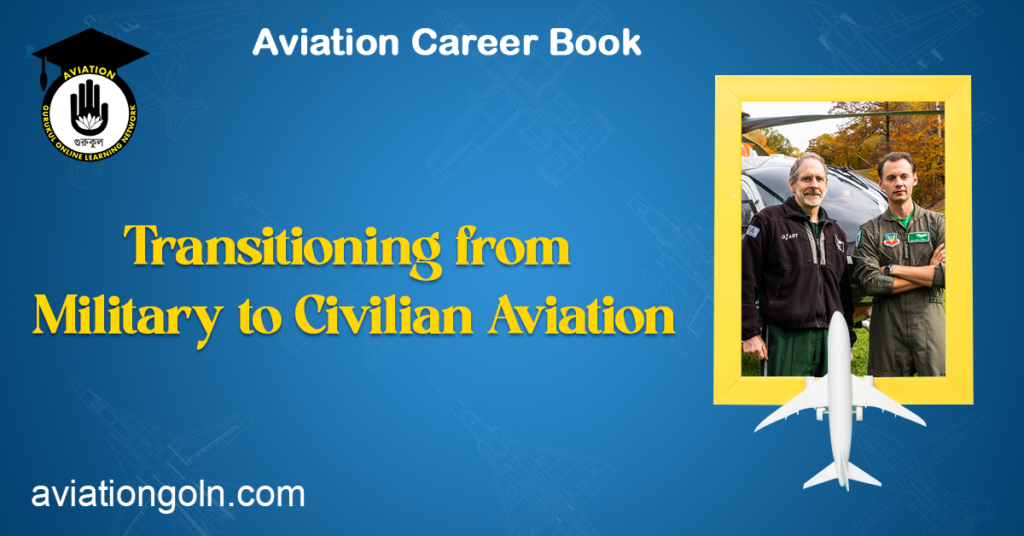Transitioning from Military to Civilian Aviation: Military aviation provides unique experiences, training, and discipline that can significantly benefit civilian aviation industries. From piloting to aircraft maintenance, many skills acquired in military aviation are transferable and highly sought-after in the civilian sector. As more military aviators and technicians seek opportunities outside defense forces, it’s essential to understand how they can transition their expertise into civilian aviation careers successfully.
Transitioning from Military to Civilian Aviation: Military Aviation Careers
1. The Broad Spectrum of Military Aviation Careers
The military doesn’t just train pilots; it prepares air traffic controllers, maintenance technicians, flight operations specialists, and aviation safety experts. The breadth of skills and expertise acquired while serving in the military opens up a multitude of civilian opportunities.
- Pilots: Fly various aircraft, including fighter jets, helicopters, and transport planes.
- Air Traffic Controllers: Manage the movements of aircraft within military airspace.
- Maintenance Technicians: Responsible for ensuring that all military aircraft are operationally ready.
- Flight Operations Specialists: Manage logistics related to flights, such as planning and coordination.
- Aviation Safety Experts: Ensure the safe operations of military aircraft.
2. Why Military Aviators and Technicians are Valued in Civilian Aviation
a. Disciplined Training:
Military aviation professionals undergo rigorous training, ensuring they’re prepared for any situation. This level of discipline translates well into the civilian sector.
b. Handling Pressure:
Military operations can be intense. Professionals trained under such conditions develop the ability to handle high-pressure situations, making them valuable assets, especially in emergency situations in civilian aviation.
c. Advanced Technical Knowledge:
Military aviation often exposes professionals to advanced technology and equipment, making their technical knowledge unparalleled.
3. Transitioning to Civilian Aviation: The Steps
a. Recognize Transferable Skills:
While the environments may differ, many skills acquired in the military, such as leadership, teamwork, and technical know-how, are directly transferable to civilian roles.
b. Obtain Necessary Certifications:
Depending on the country, transitioning military pilots might need to obtain a civilian pilot’s license or convert their military license. Technicians might need specific certifications recognized by civilian regulatory bodies.
c. Networking:
Building relationships in the civilian aviation industry can be crucial. Networking can open doors to job opportunities and ease the transition by connecting with those who have made the shift before.
d. Education and Further Training:
Pursuing additional education or training can make transitioning smoother. Many institutions offer courses tailored to help military personnel adjust to civilian roles.
4. Potential Civilian Careers for Military Aviation Professionals
a. Commercial Pilots:
Military pilots can transition to piloting commercial airlines, cargo planes, or charter flights. With the growing demand for pilots globally, airlines often value the experience and discipline military pilots bring.
b. Corporate or Private Pilots:
Many companies and wealthy individuals employ pilots for their private jets, valuing the professionalism and punctuality often seen in ex-military pilots.
c. Air Traffic Controllers:
Military air traffic controllers can often transition to similar roles in civilian airports or control centers.
d. Aircraft Maintenance:
Those who worked as technicians in the military can work in aircraft maintenance for airlines, private companies, or maintenance service providers.
e. Aviation Safety Consultants:
Military aviation safety experts can offer their expertise as consultants for airlines, manufacturers, or regulatory bodies.
f. Flight Instructors:
With their rigorous training and extensive flying experience, many ex-military pilots take roles as flight instructors at civilian training institutions.
5. Challenges in Transitioning
a. Cultural Adjustments:
The hierarchical and disciplined environment of the military can differ significantly from civilian sectors. Adapting to a new organizational culture might be challenging.
b. Certification Hurdles:
While military training is robust, civilian regulatory bodies might still require additional certifications or licenses.
c. Age Factor:
Military pilots transitioning late in their careers might face age restrictions, especially in commercial airlines.
d. Differences in Equipment:
The type of aircraft and equipment used in the military can differ from civilian counterparts. Some retraining might be needed.
6. Overcoming Transitioning Challenges
a. Preparing in Advance:
Begin the transition process well before leaving military service. Research, network, and acquire any necessary certifications ahead of time.
b. Seek Mentorship:
Find someone who has successfully transitioned and seek their advice and guidance.
c. Stay Updated:
The aviation industry, especially on the civilian side, evolves rapidly. Regularly updating oneself on the latest trends, equipment, and regulations is crucial.
d. Flexibility:
Be open to different roles or positions. The first job post-military might not be the dream job, but it’s a step in the right direction.
The shift from military to civilian aviation is a journey of adapting skills, learning, and growth. With the right mindset, preparation, and resources, military aviation professionals can find fulfilling and successful second careers in the civilian sector. Their unparalleled experience, discipline, and technical knowledge make them invaluable assets to the world of civilian aviation, enriching the industry with their unique perspectives and skills.

